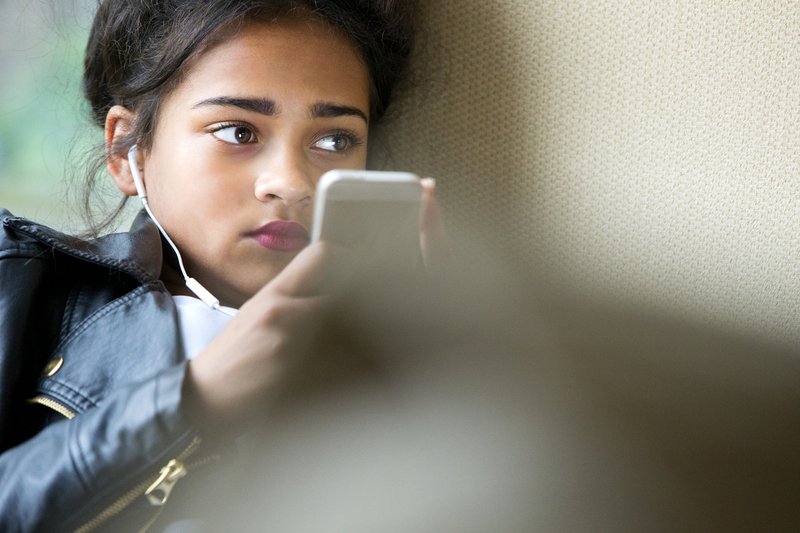
SAIRA PEESKER
April 20, 2020
When Adelaide Crawford gets to Grade 6, she’ll get a phone plan that allows her to text and make calls. The Hamilton 10-year-old has had her own WiFi-enabled device for years – she had an iPad before getting a hand-me-down iPhone 6 – and has been staying in touch with her friends lately through apps such as iMessage, FaceTime and Zoom. But once the COVID-19 pandemic is over and she’s out of the house more often, she’s excited to have a phone that works everywhere she goes.
“One of my friends has an iPhone with data and everything,” she says, adding her current situation is in the middle of the pack among her peers. “Most kids seem to have to ask before they download a game, some kids have to stay off social-media platforms and some are not allowed to text at all.”

Getting a child their first cellphone is a tricky endeavour – what is the right age and how should parents regulate a child’s usage? How can they make sure they don’t lose it? Several parents who spoke with The Globe and Mail said they put off the decision as long as they could, but caved when their child was becoming more independent and they wanted to stay in touch. Experts say a first phone can be used to teach budgeting and self-control, but only if families set clear rules and make sure their children understand why.
The Crawford family’s rules around cellphones developed when Adelaide’s older sister was about to start taking public transit to middle school. “We wanted to get a hold of her but didn’t want her playing on her phone all the time,” says their mother, Lissa. Adelaide’s siblings are 16 and 13, in Grades 10 and 8.
The family rules allow children to get texting and calling in Grade 6 (plans that cost $15 a month), and in high school, they are added to Lissa’s plan, which includes data. The younger two can only download apps with parental permission, and the oldest must pay for any data overages herself.
Those rules fall in line with the recommendations from MediaSmarts, an Ottawa organization focused on digital literacy. Director of education Matthew Johnson says they recommend a first phone be mainly used for communication: “If your concern is safety, usually phoning and texting is sufficient.”
The organization has studied Canadian children’s device use extensively, and found that among children 10 to 13, more than half have a cellphone. By 15 or 16, three-quarters have a smartphone. He says that in some families, owning a device has almost no age threshold. “A significant minority of kids ages zero to 4 have their own cellphone,” Mr. Johnson said.
When it comes to using the phone as a tool to teach financial responsibility, he says it’s best if the child already has some understanding of money. “If the phone is the only financial responsibility the child has, it may not make a lot of sense. If you’re using the phone as part of a larger approach to … help your child learn how to live by a budget and make sure their use of data is within their budget, that is a good approach.”
Mr. Johnson says it’s important to discuss the rules ahead of time, rather than surprising children with a punishment the first time they err. He says MediaSmarts’ research has found clear rules and active parenting work better than technological controls in guiding a child’s phone use.
Parents opting for just calling and text can get an annual plan from Telus for $180, including unlimited texting, evening and weekend local calls, and 180 local daytime minutes to use over the entire year. Alternatively, a plan for $10 a month buys 50 texts and 50 minutes of local phone calls.
Another option is adding a child’s phone to a family plan. For families who don’t need to buy a phone, Bell’s most basic multidevice plan costs $85 a month, including unlimited calling in Canada and 10 gigabytes of shared data.
Robin Taub, author of A Parent’s Guide to Raising Money-Smart Kids, says if parents want the phone to be a financial lesson, “the key is to let [the kids] have some skin in the game. As long as they feel that pain of paying for it in some way, and understand that if they want more features, or a newer phone, it’s going to cost more money.”
For younger children who don’t work, Ms. Taub suggests an early lesson can be proving they are able to care for the handset itself. She suggests starting with a hand-me-down phone with minimal service, and having a conversation about what everything costs and who will cover what costs. “By proving they’re responsible, they could earn the right to a newer or better phone the next time, as they get older and have greater need for it.”
For older children with an income, Ms. Taub says they should pay for the phone themselves, which could be part of a lesson in the difference between needs and wants. If they can’t afford it on their own, she suggests sharing the cost in a way that seems reasonable. “They always want the newest phone, the latest phone. They’re expensive.”
She also says the plethora of financial transactions that can now be done with a smartphone – such as using Apple Pay or Google Pay to draw directly from a bank account, or paying for an Uber ride. Teens must be the age of majority to get their own credit card, so many are using their parents’ card numbers in these apps, she says. It’s important to set guidelines upfront, she stresses. “The question is, who’s paying?”
This Globe and Mail article was legally licensed by AdvisorStream.
© Copyright 2024 The Globe and Mail Inc. All rights reserved.


